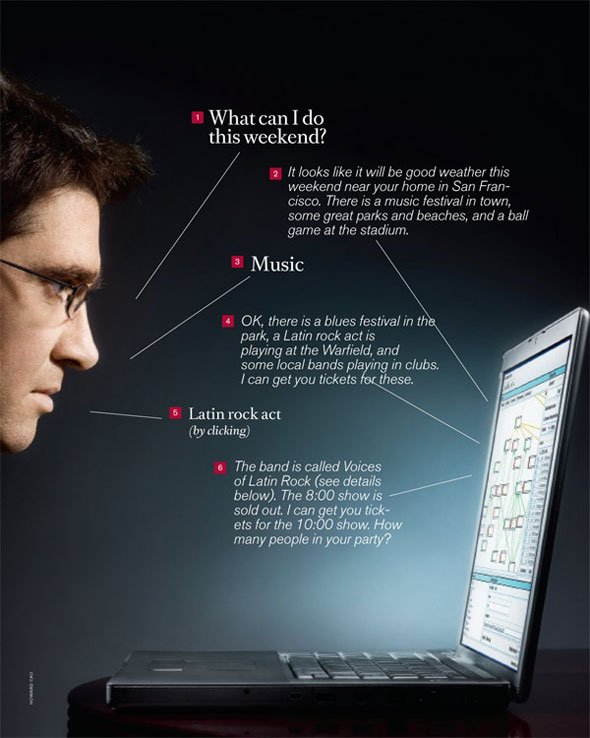Intelligent Software Assistant

Search is the gateway to the Internet for most people; for many of us, it has become second nature to distill a task into a set of keywords that will lead to the required tools and information. But Adam Cheyer, cofounder of Silicon Valley startup Siri, envisions a new way for people to interact with the services available on the Internet: a “do engine” rather than a search engine. Siri is working on virtual personal-assistant software, which would help users complete tasks rather than just collect information.
Cheyer, Siri’s vice president of engineering, says that the software takes the user’s context into account, making it highly useful and flexible. “In order to get a system that can act and reason, you need to get a system that can interact and understand,” he says.
Siri traces its origins to a military-funded artificial-intelligence project called CALO, for “cognitive assistant that learns and organizes,” that is based at the research institute SRI International. The project’s leaders–including Cheyer–combined traditionally isolated approaches to artificial intelligence to try to create a personal-assistant program that improves by interacting with its user. Cheyer, while still at SRI, took a team of engineers aside and built a sample consumer version; colleagues finally persuaded him to start a company based on the prototype. Siri licenses its core technology from SRI.
Mindful of the sometimes spectacular failure of previous attempts to create a virtual personal assistant, Siri’s founders have set their sights conservatively. The initial version, to be released this year, will be aimed at mobile users and will perform only specific types of functions, such as helping make reservations at restaurants, check flight status, or plan weekend activities. Users can type or speak commands in casual sentences, and the software deciphers their intent from the context. Siri is connected to multiple online services, so a quick interaction with it can accomplish several small tasks that would normally require visits to a number of websites. For example, a user can ask Siri to find a midpriced Chinese restaurant in a specific part of town and make a reservation there.
Recent improvements in computer processor power have been essential in bringing this level of sophistication to a consumer product, Cheyer says. Many of CALO’s abilities still can’t be crammed into such products. But the growing power of mobile phones and the increasing speed of networks make it possible to handle some of the processing at Siri’s headquarters and pipe the results back to users, allowing the software to take on tasks that just couldn’t be done before.
“Search does what search does very well, and that’s not going anywhere anytime soon,” says Dag Kittlaus, Siri’s cofounder and CEO. “[But] we believe that in five years, everyone’s going to have a virtual assistant to which they delegate a lot of the menial tasks.”
While the software will be intelligent and useful, the company has no aspiration to make it seem human. “We think that we can create an incredible experience that will help you be more efficient in your life, in solving problems and the tasks that you do,” Cheyer says. But Siri is always going to be just a tool, not a rival to human intelligence: “We’re very practical minded.”

1. “The user can ask a broad question like this because Siri has information that gives clues about what the user intends. For example, the software might store data about the user’s location, schedule, and past activities. Siri can deal with open-ended questions within specific areas, such as entertainment or travel.”
2. “Siri pulls information relevant to the user’s question from a variety of Web services and tools. In this case, it checks the weather, event listings, and directories of local attractions and uses machine learning to select certain options based on the user’s past preferences. Siri can connect to various Web applications and then integrate the results into a single response.”
3. “Siri interprets this reply in the context of the existing conversation, using it to refine the user’s request.”
4. “The software offers specific suggestions based on the user’s personal preferences and its ability to categorize. Because Siri is task-oriented, rather than a search engine, it offers to buy tickets that the user selects.”
5. “By now, the conversation has narrowed enough that all the user has to do is click on his choice.”
6. “Siri compiles information about the event, such as band members, directions, and prices, and structures it in a logical way. It also handles the task of finding out what’s available and getting the tickets.”
Keep Reading
Most Popular
Large language models can do jaw-dropping things. But nobody knows exactly why.
And that's a problem. Figuring it out is one of the biggest scientific puzzles of our time and a crucial step towards controlling more powerful future models.
The problem with plug-in hybrids? Their drivers.
Plug-in hybrids are often sold as a transition to EVs, but new data from Europe shows we’re still underestimating the emissions they produce.
Google DeepMind’s new generative model makes Super Mario–like games from scratch
Genie learns how to control games by watching hours and hours of video. It could help train next-gen robots too.
How scientists traced a mysterious covid case back to six toilets
When wastewater surveillance turns into a hunt for a single infected individual, the ethics get tricky.
Stay connected
Get the latest updates from
MIT Technology Review
Discover special offers, top stories, upcoming events, and more.